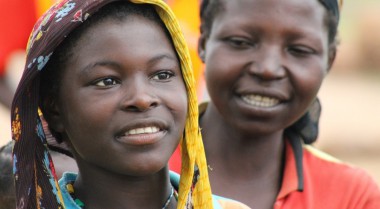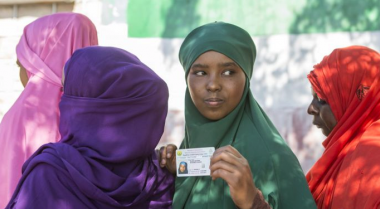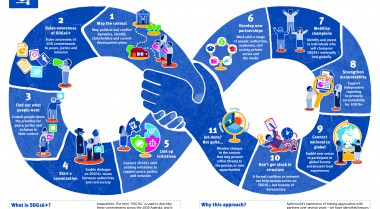
Making SDG 16.3 Work for the Rule of Law and Access to Justice: Measuring Progress in Fragile and Conflict-affected States
In Fragile and Conflict-affected States (FACS), how do we increase access to justice and rule of law in a way that benefits those left furthest behind in line with the aspirations of the 2030 Agenda for Sustainable Development and measure the progress along the way? This question was addressed during a public event in the Peace Palace in The Hague on September 28 and subsequent roundtable discussion organized by the Institute for Economics & Peace (IEP) and hosted at The Hague Institute for Global Justice on September 28 and 29 [1]. Both events convened representatives of g7+ countries [2] – Sierra Leone, Afghanistan and Liberia –, members of the g7+ Secretariat based in Timor-Leste, senior representatives of IEP, the Oslo Governance Centre and the International Development Law Organization as well as policymakers, practitioners and researchers based in The Hague.
Conditions for progressing on peace and development
Since the MDGs were agreed upon in 2000, there has been a shift in the thinking about measuring development, namely to address the factors that are integral to development rather than a narrow focus on development outcomes. One major finding from the review of MDG progress was that conflict and violence severely impacted on development progress in many countries. Low-income and FCAS recorded much lower levels of MDG achievement. For that particular reason, the g7+ countries (together with other partners of the International Dialogue on Peacebuilding and Statebuilding) actively lobbied for the inclusion of SDG 16,[3] as part of the 2030 Agenda for Sustainable Development.
The common understanding behind SDG16 is that progress on peace and development depends on the creation of inclusive societies in which the rule of law and human rights are respected. While SDG Target 16.3 on rule of law and access to justice helpfully captures this ambition, the longer-term challenge is determining how progress will be measured and ensuring that monitoring in turn strengthens the rule of law and access to justice for rights holders.
Indicators that measure progress, or not?
There are generally two ways of measuring progress in countries – over time and in comparison to other countries. Despite the multidimensional characteristics of a large concept like rule of law, only two indicators have been identified so far by the Inter-agency Expert Group on SDG Indicators (IAEG-SDGs). By stark contrast, the United Nations Rule of Law employ 135 indicators. The first SDG16.3 indicator (16.3.1) is the crime reporting rate that seeks to measure the proportion of victims of violence who had reported being victims. The second official indicator (16.3.2) measures unsentenced detainees as a percentage of a country's overall prison population. The latter is actually one of the three indicators the g7+ countries jointly adopted for monitoring SDG 16.
The concern by many experts, including those present during both events, is that the two SDG16.3 indicators are too narrow and do not sufficiently capture actual progress on rule of law and access to justice. Another concern is the gap in official data. A recent comprehensive global audit of progress on available SDG16 indicators by IEP revealed that there is no official comparable data available on the crime reporting rate. On a more optimistic note, the same report found that the percentage of total detainees who have not yet been sentenced data is available for 146 countries. These issues are reflective of concerns surrounding the measurement of SDG16 overall. IEP's aforementioned report concluded that comparable data for measuring Goal 16 is still in short supply for many indicators and countries. Eight out of twenty-two indicators have data for less than 50 per cent of countries, while only seven have data for more than 90 per cent of 163 countries in the world. Data coverage is particularly weak in FCAS because of lower statistical capacity.
The concern by many experts, including those present during both events, is that the two SDG16.3 indicators are too narrow and do not sufficiently capture actual progress on rule of law and access to justice. Another concern is the gap in official data. A recent comprehensive global audit of progress on available SDG16 indicators by IEP revealed that there is no official comparable data available on the crime reporting rate. On a more optimistic note, the same report found that the percentage of total detainees who have not yet been sentenced data is available for 146 countries. These issues are reflective of concerns surrounding the measurement of SDG16 overall. IEP's aforementioned report concluded that comparable data for measuring Goal 16 is still in short supply for many indicators and countries. Eight out of twenty-two indicators have data for less than 50 per cent of countries, while only seven have data for more than 90 per cent of 163 countries in the world. Data coverage is particularly weak in FCAS because of lower statistical capacity.
Data is inherently political, especially during elections. To protect national interests, the gathering of data and the publication of results are typically subject to validation by national authorities.
Methodological and practical challenges
There are also numerous methodological and complex practical challenges in measuring SDG16.3. For instance, data that is being collected on victimization through surveys in Sierra Leone and Liberia showed there are difficulties in comparing the underreporting rates. Different rates could reflect a lack of trust in authorities or cultural differences, even at the subnational level. This includes a divergent understanding of what behaviour constitutes a crime or whether there is a culture of not reporting grievances. Currently, the National Statistics Offices, that are responsible for gathering official data, do not appear to have the necessary and sufficient technological, financial and human resource capacities to collect and analyse the data.
Further, there is a lack of ‘space' at the local level in countries for people and civil society actors to play a role in independent monitoring, for instance in measuring corruption. Without a clear definition on corruption and a proper and safe reporting system, it is unlikely that people will come forward as citizen surveys in Liberia have demonstrated.
Politics and differing perceptions around data
Data is inherently political, especially during elections. To protect national interests, the gathering of data and the publication of results are typically subject to validation by national authorities. This makes cross-country comparisons difficult as a certain level of harmonization is necessary from an international data measurement perspective. Harmonization enables not only comparison but can also strengthen the accountability of duty bearers.
While data requires validation at the national level and harmonization at the international level, it also needs to be accepted at the local level, thus by the people. This means that data captured needs to be relevant to a country's citizens to obtain its legitimacy. However, indicators can be biased where based on perceptions. For example, ‘access to justice' has different meanings in different contexts and cultures in terms of both ‘access' and the type of justice which may be retributive, restorative, informal or a combination of several types, especially in conflict-affected countries that frequently inherit pluralist systems of justice and a composition of mechanisms to fill gaps at the community level.
Summary and next steps
The outline of these concerns above demonstrate significant dissonance between the international demands and the realities that FCAS face on the ground. This mismatch can be observed in the broader SDG16 framework. For example, Afghanistan is asked to monitor and measure progress on the rule of law and access to justice indicators while it is occupied with security issues including dealing with terrorism, drugs and foreign interventions for which no indicators currently exist. These contextualized priorities that are high on the agenda of many g7+ countries are missing in the SDG16 framework but ultimately need to be reconciled at the conceptual and operational levels if the monitoring and reporting on the 2030 Agenda is to receive the attention and support needed in these countries.
In addressing this particular challenge, the g7+ and the Civil Society Platform for Peacebuilding and Statebuilding assert that, in the case of Afghanistan, the outcomes of its own fragility assessment should be taken into account when embarking on the actualization of the 2030 Agenda, with particular relevance to the prioritization of action and means of verification. In other words, it is imperative to understand, gain international support and follow through on linkages and synergies between the fragility assessment and the measurement of SDG16. Linking both may better inform national development plans, and more profoundly, transitions out of war and violence.
As such, the g7+ countries are encouraged to develop localized indicators from their fragility assessments, which can supplement the global SDG16 indicators. This requires contextualization of the indicators and a common understanding on any definitions and methodologies used.
In order for measurements to be relevant nationally and comparable internationally, the methodologies for data collection and the indicators need to be uniform and harmonized among g7+ countries. This balance between what is relevant for these countries and ensuring that data meets the international standards can potentially be achieved by reaching an agreement on how data is collected, verified, recorded and shared.
In conclusion, the multidimensional aspects of the rule of law and access to justice remain difficult to capture through global indicators only. This article has argued that we need to approach the rule of law and access to justice as a cultural endeavour. Determining how best to measure SDG16.3 requires a multi-stakeholder approach and in that way to build on the more participatory approach to designing the SDGs compared to the MDGs. Such an approach is not only important for technical and political reasons. As a process, it has the potential to strengthen institutions and to promote peace and inclusiveness within societies, which is after all, the purpose of SDG16.
------
[1] The public event and roundtable titled "Making SDG 16.3 Work for the Rule of Law and Access to Justice – Measuring Progress in Fragile and Conflict-affected States" was organized by the Institute for Economics & Peace together with The Hague Institute for Global Justice, Cordaid/Civil Society Platform for Peacebuilding and Statebuilding, Hague University of Applied Sciences, Humanity X, Carnegie Foundation and with the support of the Knowledge Platform for Security and Rule of Law and the Dutch Ministry of Foreign Affairs. Following the roundtable in The Hague, representatives of IEP and Cordaid/Civil Society Platform for Peacebuilding and Statebuilding, presented the findings during a roundtable discussion of the World Federation of United Nations Associations organized SDG16 + Annual Showcase Forum in Tbilisi/Georgia on October 31st, 2017.
[2] The g7+ is a voluntary association of countries that are or have been affected by conflict and are now in transition to the next stage of development.
[3] Promote peaceful and inclusive societies for sustainable development, provide access to justice for all and build effective, accountable and inclusive institutions at all levels.
------
Blog post by Marcel Smits, David Connolly and Peter van Sluijs.



